Analog chipmaker Microchip Technology (NASDAQ:MCHP) reported results in line with analysts' expectations in Q3 FY2024, with revenue down 18.6% year on year to $1.77 billion. On the other hand, next quarter's revenue guidance of $1.33 billion was less impressive, coming in 19.6% below analysts' estimates. It made a non-GAAP profit of $1.08 per share, down from its profit of $1.56 per share in the same quarter last year.
Microchip Technology (MCHP) Q3 FY2024 Highlights:
- Revenue: $1.77 billion vs analyst estimates of $1.76 billion (small beat)
- EPS (non-GAAP): $1.08 vs analyst estimates of $1.04 (3.8% beat)
- Revenue Guidance for Q4 2024 is $1.33 billion at the midpoint, below analyst estimates of $1.65 billion
- Free Cash Flow of $793.8 million, up 46.5% from the previous quarter
- Inventory Days Outstanding: 185, up from 167 in the previous quarter
- Gross Margin (GAAP): 63.4%, down from 67.8% in the same quarter last year
- Market Capitalization: $46.09 billion
Spun out from General Instrument in 1987, Microchip Technology (NASDAQ: MCHP) is a leading provider of microcontrollers and integrated circuits used mainly in the automotive world, especially in electric vehicles and their charging devices.
Microchip is a leading provider of microprocessors (MPUs) which are made up of microcontrollers (MCUs) and Digital Signal Controllers (DSCs). Microcontrollers are effectively mini computers on a chip, they consist of a CPU, some memory, an analog chip, and a simple, application specific software that tells the chip what to do.
Microchip’s microcontrollers are low cost customized chips that are in thousands of products. Examples would be automobile engine control systems, implantable medical devices, remote controls, office machines, appliances, power tools, or toys.
Digital Signal Controllers are a variation of microcontroller that measures, filters and/or compresses digital or analog signals. They are used in motor control, power conversion, and sensor processing applications, often in the same types of systems as a microcontroller.
Microchip has a design ecosystem and library of off-the-shelf components that allows its customers to design any kind of custom microprocessor they can think of.
Microchips’ peers and competitors include Texas Instruments (NASDAQ:TXN), Skyworks (NASDAQ:SWKS), and Infineon (XTRA:IFX), among others.Analog Semiconductors
Longer manufacturing duration allows analog chip makers to generate greater efficiencies, leading to structurally higher gross margins than their fabless digital peers. The downside of vertical integration is that cyclicality can be more pronounced for analog chipmakers, as capacity utilization upsides work in reverse during down periods.
Sales Growth
Microchip Technology's revenue growth over the last three years has been mediocre, averaging 17.8% annually. But as you can see below, its revenue declined from $2.17 billion in the same quarter last year to $1.77 billion. Semiconductors are a cyclical industry, and long-term investors should be prepared for periods of high growth followed by periods of revenue contractions (which can sometimes offer opportune times to buy).
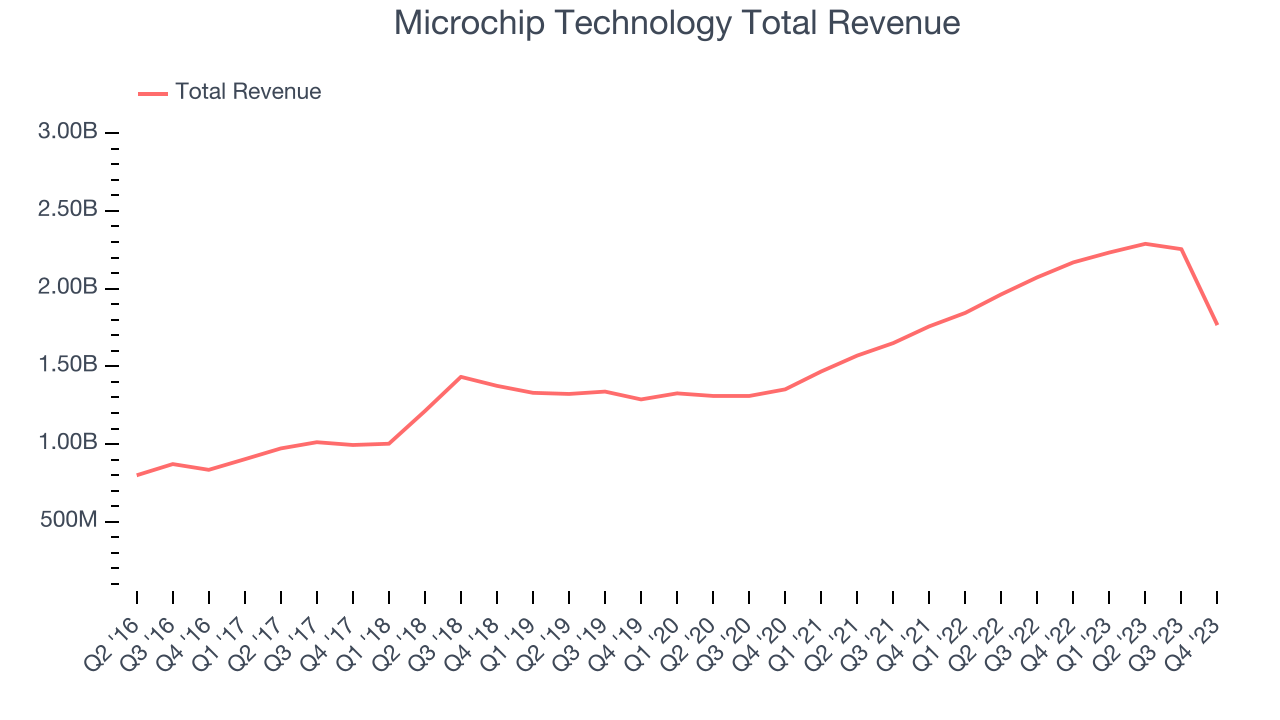
This was a slow quarter for the company as its revenue dropped 18.6% year on year, in line with analysts' estimates.
Microchip Technology's revenue inverted from positive to negative growth this quarter, which was unfortunate to see. Looking ahead to the next quarter, the company's management team forecasts a 40.7% year-on-year revenue decline. Analysts seem to agree that the poor performance will continue, as their estimates for the next 12 months call for a 15.7% drop in revenue.
Product Demand & Outstanding Inventory
Days Inventory Outstanding (DIO) is an important metric for chipmakers, as it reflects a business' capital intensity and the cyclical nature of semiconductor supply and demand. In a tight supply environment, inventories tend to be stable, allowing chipmakers to exert pricing power. Steadily increasing DIO can be a warning sign that demand is weak, and if inventories continue to rise, the company may have to downsize production.
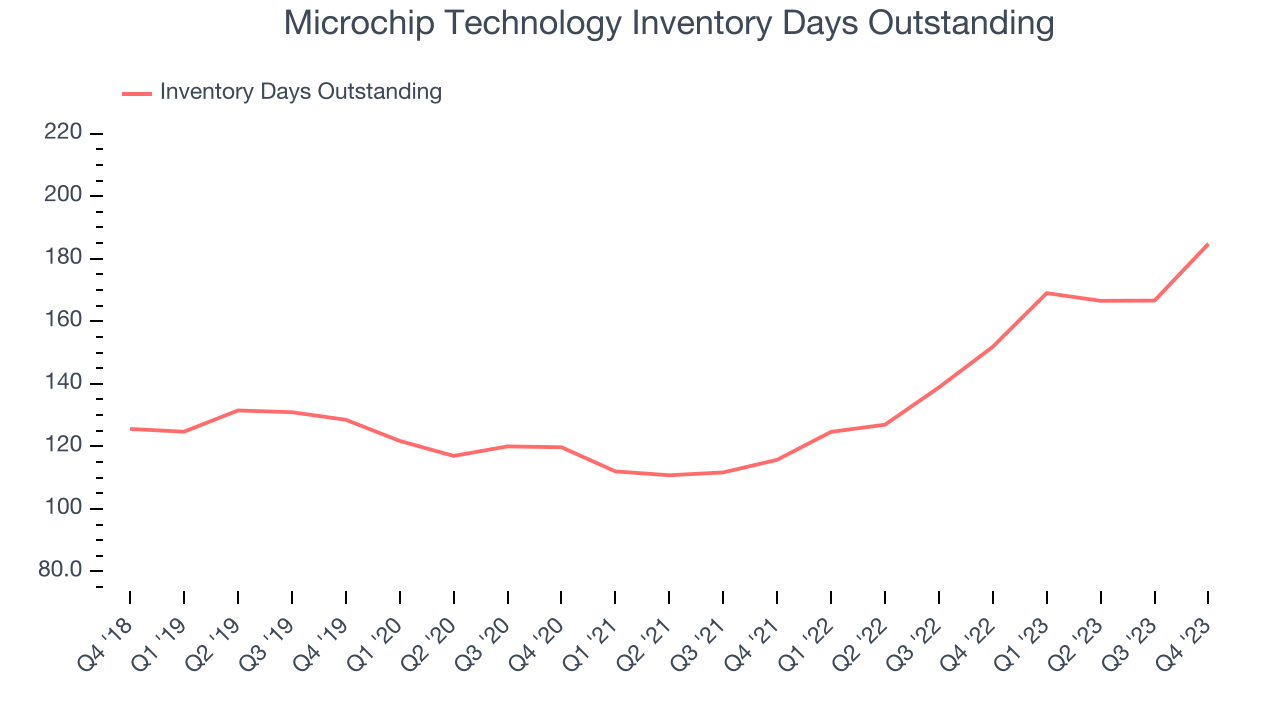
This quarter, Microchip Technology's DIO came in at 185, which is 51 days above its five-year average, suggesting that the company's inventory has grown to higher levels than we've seen in the past.
Pricing Power
In the semiconductor industry, a company's gross profit margin is a critical metric to track because it sheds light on its pricing power, complexity of products, and ability to procure raw materials, equipment, and labor. Microchip Technology's gross profit margin, which shows how much money the company gets to keep after paying key materials, input, and manufacturing costs, came in at 63.4% in Q3, down 4.4 percentage points year on year.
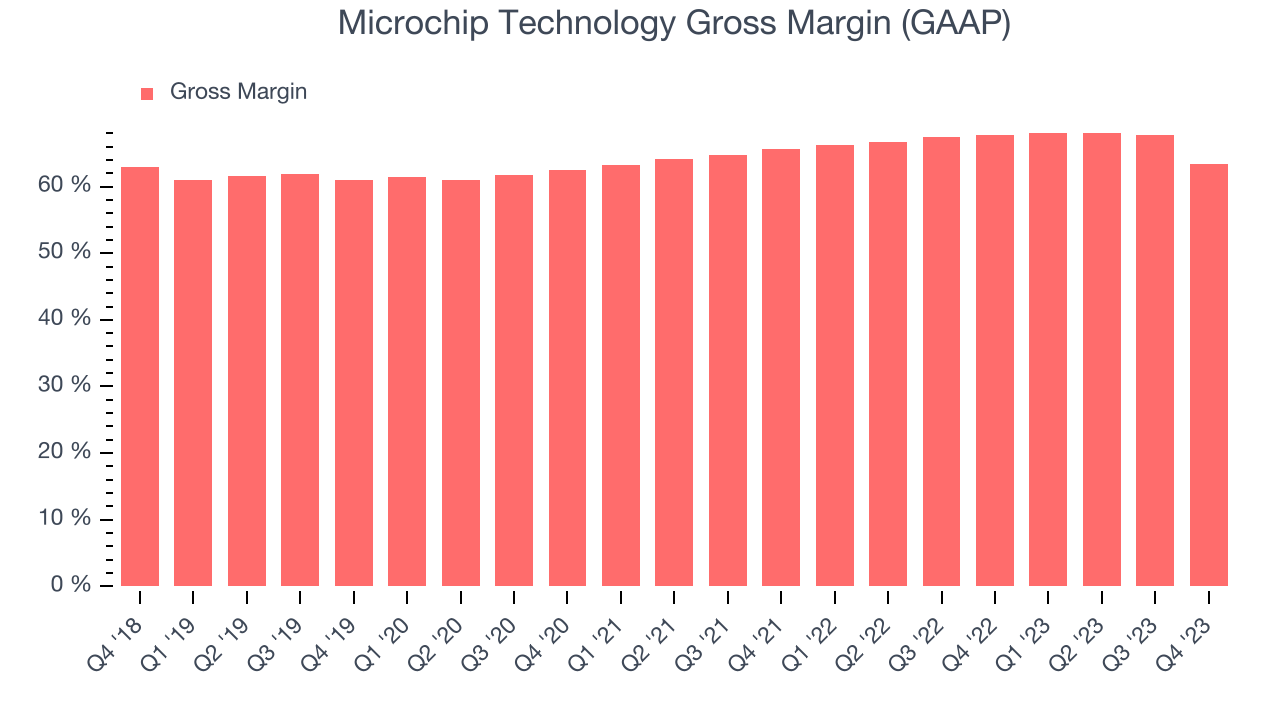
Gross margins have been relatively stable over the last year, averaging 66.8%. Microchip Technology's gross margins are some of the best in the semiconductor peer group, driven by strong pricing power from its differentiated, value-add products.
Profitability
Microchip Technology reported an operating margin of 41.2% in Q3, down 6.2 percentage points year on year. Operating margins are one of the best measures of profitability because they tell us how much money a company takes home after manufacturing its products, marketing and selling them, and, importantly, keeping them relevant through research and development.
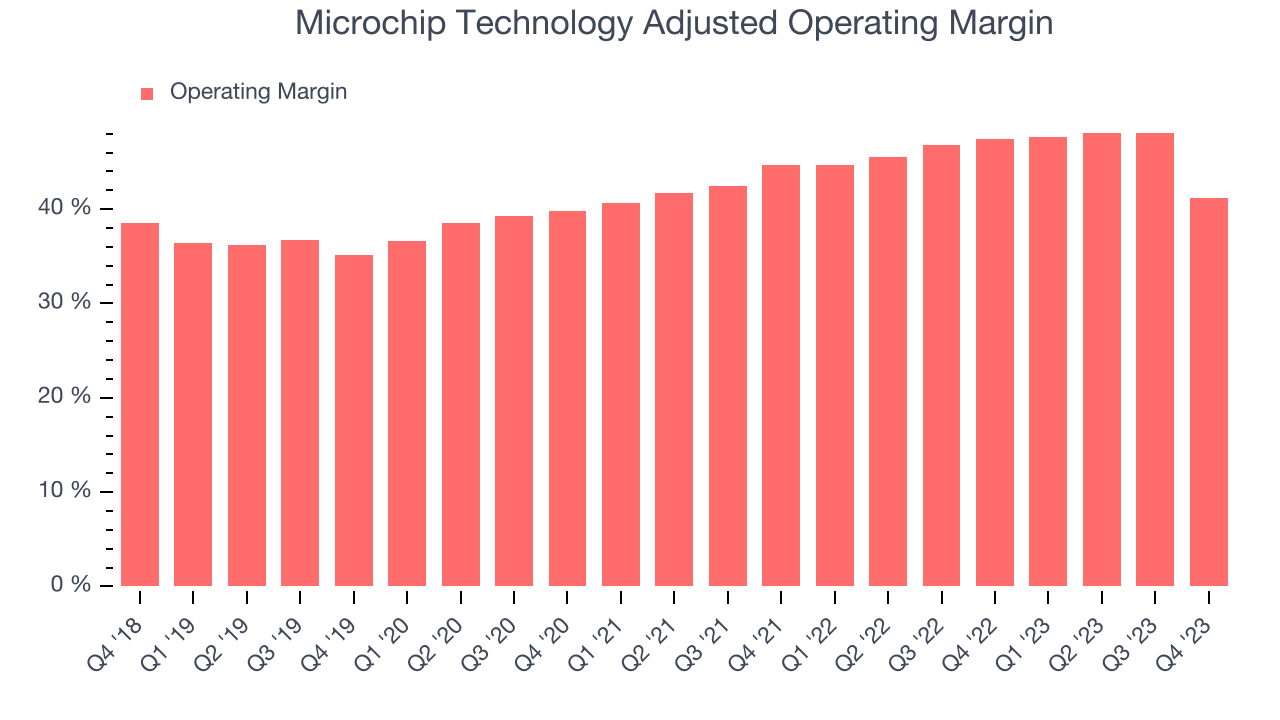
Microchip Technology's operating margins have been stable over the last year, averaging 46.3%. Furthermore, the company's margins are higher than most in the semiconductor industry, showcasing how efficiently the business is managed.
Earnings, Cash & Competitive Moat
Wall Street expects earnings per share to decline 26.8% over the next 12 months, although estimates will likely change after earnings.
Although earnings are important, we believe cash is king because you can't use accounting profits to pay the bills. Microchip Technology's free cash flow came in at $793.8 million in Q3, down 30.2% year on year.
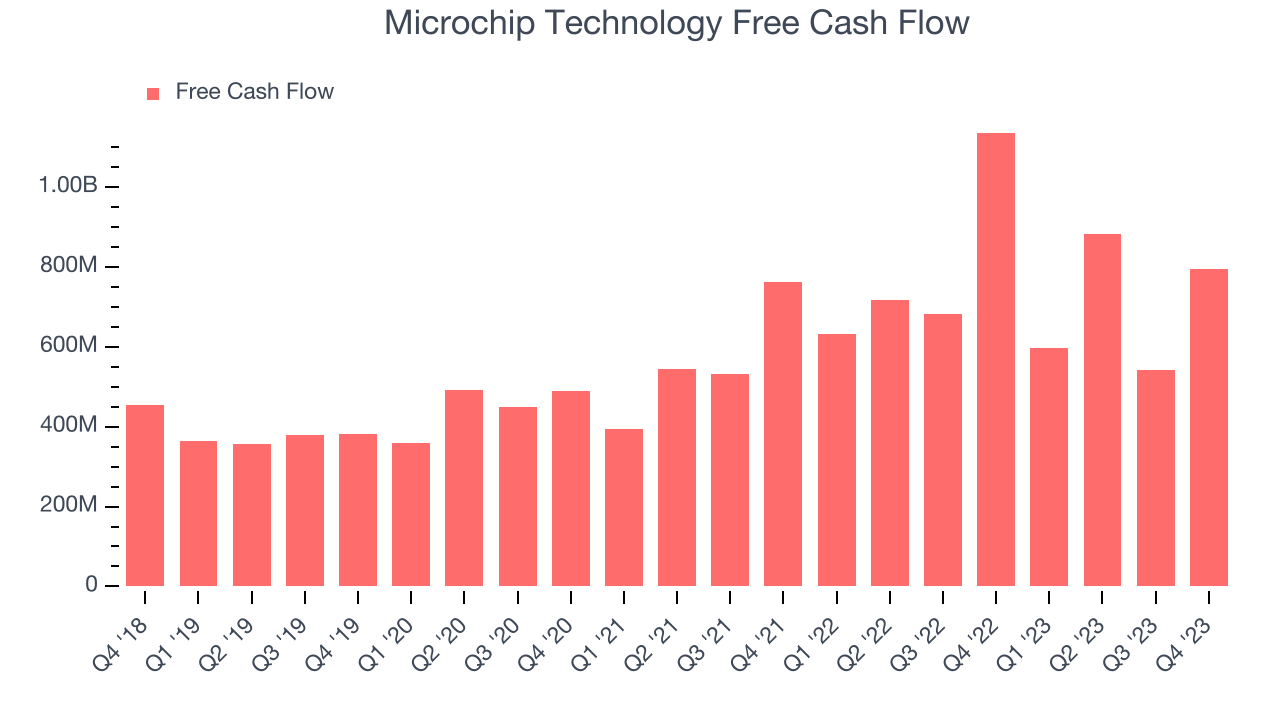
As you can see above, Microchip Technology produced $2.81 billion in free cash flow over the last 12 months, an eye-popping 33.6% of revenue. This is a great result; Microchip Technology's free cash flow conversion places it among the best semiconductor companies and, if sustainable, puts the company in an advantageous position to invest in new products while remaining resilient during industry downturns.
Return on Invested Capital (ROIC)
EPS and free cash flow tell us whether a company's revenue growth was profitable. But was it capital-efficient? If two companies had equal growth, we’d prefer the one with lower reinvestment requirements.
Understanding a company’s ROIC (return on invested capital) gives us insight into this because it factors the total debt and equity needed to generate operating profits. This metric is a proxy for not only the capital efficiency of a business but also a management team's ability to allocate limited resources.
Microchip Technology's five-year average ROIC was 13%, somewhat low compared to the best semiconductor companies that consistently pump out 35%+. Its returns suggest it historically did a subpar job investing in profitable growth initiatives.
The trend in its ROIC, however, is often what surprises the market and drives the stock price. Over the last two years, Microchip Technology's ROIC has averaged a 12.4 percentage point increase each year. This is a good sign, and if Microchip Technology's returns keep rising, there's a chance it could evolve into an investable business.
Key Takeaways from Microchip Technology's Q3 Results
It was good to see Microchip Technology beat analysts' EPS expectations this quarter. That stood out as a positive in these results. On the other hand, its revenue guidance for next quarter missed analysts' expectations and its inventory levels increased. Management noted it is seeing weak demand as customers are overflowing with inventory. To cope with the lower sales outlook, Microchip plans to limit discretionary spending and tightly manage its inventory levels. In March and June, the company intends to have a two-week shutdown of its large wafer fabrication facilities. It will also reduce activity in many other factories, resulting in underutilization charges. Overall, the results could have been better. The company is down 3.3% on the results and currently trades at $82.8 per share.
Is Now The Time?
Microchip Technology may have had a bad quarter, but investors should also consider its valuation and business qualities when assessing the investment opportunity.
Although Microchip Technology is't a bad business, it probably wouldn't be one of our picks. Although its revenue growth has been solid over the last three years, Wall Street expects growth to deteriorate from here. On top of that, its relatively low ROIC suggests it has struggled to grow profits historically.
Microchip Technology's price-to-earnings ratio based on the next 12 months is 20.5x. We don't really see a big opportunity in the stock at the moment, but in the end beauty is in the eye of the beholder. And if you like the company, it seems that Microchip Technology doesn't trade at a completely unreasonable price point.
To get the best start with StockStory check out our most recent Stock picks, and then sign up to our earnings alerts by adding companies to your watchlist here. We typically have the quarterly earnings results analyzed within seconds of the data being released, and especially for the companies reporting pre-market, this often gives investors the chance to react to the results before the market has fully absorbed the information.
